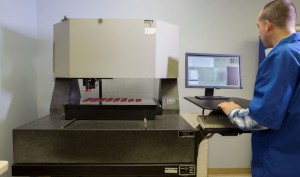Here at Apple Rubber, our goal is to provide quality parts that meet or exceed our customers’ expectations. Our parts are used in various devices across a broad range of industries. Because of that, our customers’ needs differ according to industry standards and regulations in their respective fields.
That’s why we provide a wide variety of quality documentation for our customers. To help you better understand the process, we broke down some types of quality documents.
First Article Inspection Report
A first article inspection is a documented dimensional inspection process that verifies the given part(s) meet all required customer drawing specifications.
AS-9102 First Article Inspection Report
An AS-9102 first article inspection form is used to provide a consistent format for reporting first article information to aerospace customers. It verifies that the given part(s) meet all required customer drawing specifications.
Measurement System Analysis (MSA) or Gage Repeatability and Reproducibility (GR&R)
A Gage R&R is used to ensure the proper equipment, people and procedures are in place to accurately measure a given part. To this end, a GR&R is executed to evaluate the amount of variability in a measurement system.
This level of quality assurance provides comfort in knowing that parts can be measured using automated technology independent of operator influence. This document ensures that parts will be measured in a consistent fashion that will yield similar results to industry standards.
Quality Control Plan
A quality control plan lists manufacturing processes and their associated tools, characteristics, specifications, evaluation techniques, control methods and reaction plans. The goal is to ensure that each individual process within the progression of manufacturing processes is structured such that it creates final parts that meet customer specifications.
The quality control plan provides more information than simply a finished good and a certificate. It also purposefully creates a joint dialogue with the engineering, manufacturing, and quality departments to ensure the part will meet or exceed customer expectations.
Process Flow Diagram (PFD)
A process flow diagram is a visual representation of the flow of a manufacturing process as well as the associated quality control checkpoints. Specific symbols are used to represent manufacturing processes, inspection points, decision points, documents, loops and their interactions.
Standard Capability Study
A capability study is conducted to determine if particular part dimensions are likely to meet customer requirements during production. Part dimensions that fail to meet index values may cause some or all parts to fail dimensional inspection.
This may require a customer to re-evaluate design requirements or critical to quality (CTQ) requirements. Identifying these issues prior to production can help mitigate problems long-term.
Certificate of Conformance (CoC)
A certificate of conformance document is used to assure supplier compliance with customer requirements. This document helps with lot identification and traceability as well as order information for customer records. This is typically provided with each shipment of the part.
Process Failure Mode Effects Analysis (PFMEA)
A PFMEA is a structured approach to review and analyze a process to ensure potential problems have been identified and their associated risks have been documented. The PFMEA is most useful when it is integrated into the process development cycle and is updated as the process changes.
This analysis will create a dialogue between process owners and subject matter experts across the engineering, manufacturing and quality departments. It will also identify processing points where additional action must be taken to ensure proper production and monitoring of customer parts. As we make various shapes and sizes of parts, different attention must be given to each in specific areas to guarantee the quality of the parts.
Production Part Approval Process (PPAP)
A PPAP is a standardized format to communicate and document part specification and approval requirements. It helps determine if the manufacturing process is capable of consistently producing parts that meet the required specifications in a production setting. PPAP’s can be tailored to fit specific customer requirements to various levels of detail. Activities that are generally included in the documentation include development of a process flow diagram (PFD), process failure mode and effects analysis (PFMEA), control plan, Gage R&R, and a capability study.
Apple Rubber: Quality You Can Count On
Want to learn more about quality documentation? Connect with us on Twitter or LinkedIn. You can also contact our engineering team for assistance.
